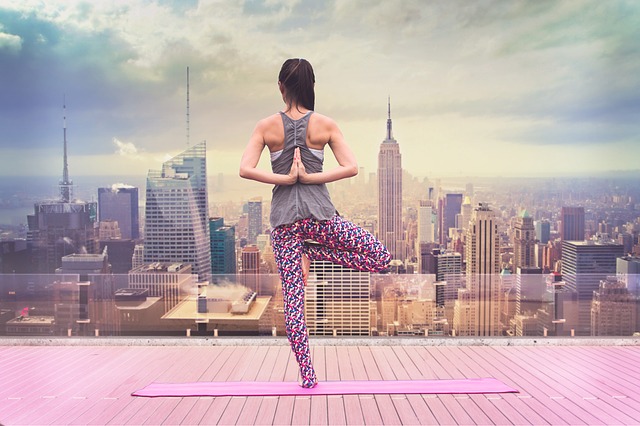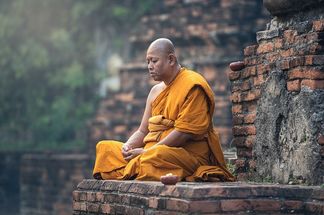Article
The Basics of Yoga [Part 1]
Determining a style of yoga to engage in comes with a prolific selection of studios, schools, colleges, institutes, ashrams, health, and fitness clubs, as well as come-to-you instruction, DVDs, and online instruction well, it’s mind-boggling! Then looking at differences between styles, levels, and philosophies from Hatha, Ashtanga, Bikram, Vinyasa, and derivatives there of, like iron- yoga, a combination of weights with yoga principles–once again, intriguing. Before you begin, visit several classes in your area to choose which environment and type you’d like to begin your program. Schools have beginning levels that suit all physical capabilities for kids, athletes, health-conscious individuals, pregnant women, seniors, and challenged individuals.
A reputable source like Gaiam, the official site since 1988 for all things healthy and green, is your best bet for finding appro- priate gear and props for taking yoga classes. It is meant for individuals and businesses interested in natural health, ecolog- ical lifestyles, personal growth, and sustainable commerce.
Background
First, know that yoga is a group of ancient spiritual practices of Hinduism originating in India 5,000 years ago and was practiced regularly around 500 B.C. referring to simplicity and meditation thought to lead to spiritual experience and profound understanding into the nature of existence. The practice of asanas or postures of Hatha yoga is the most common form of yoga in the western world. At the very basic level, yoga classes link body movement with the breath, which denotes a flowing dynamic form with postures and transitions from one pose or sequence to another with inhalations and exhalations.
Hatha yoga is a particular system introduced by Yogi Swatmarama, a sage of 15th century India, and compiler of the Hatha Yoga Pradipika, a treatise considered “a stairway to the heights of Raja Yoga,” concerned with cultivating the mind using meditation (dhyana) and achieve liberation. The asanas and pranayama (control of the life force) in Raja Yoga were what the Hindu Yogis used to physically train their body for long periods of meditation. This practice is called shatkarma. The word Hatha is a compound of the words Ha and Tha meaning sun and moon and refers to the principal nadis (energy channels) of the body that must be fully operational to attain a state of meditation.
Hatha represents opposing energies: hot and cold (fire and water, following the same concept as the yin-yang), male and female, positive and negative. Hatha yoga attempts to balance mind and body via physical exercises of poses, controlled breathing, and calming the mind through relaxation and meditation. Structured poses teach poise, balance, and strength and are practiced to improve the body’s physical health and clear the mind in preparation for meditation in the pursuit of enlightenment.
Bikram Yoga (Bikram Parmar), also known as Hot Yoga, is a style developed by Bikram Choudhury and a Los Angeles, California-based company. Choudhury claims that his method is the only true Hatha yoga practiced in the West, though this is not accepted by many other schools. Bikram Yoga is practiced ideally in a room heated to 105°F (40.5°C) with a humidity of 50 percent. Classes are guided through 26 postures and two breathing exercises. Classes last approximately 90 minutes. People of all levels, ages, and body types practice together.
What’s the difference between yoga and Pilates?
Yoga unites the mind, body, and spirit. Yogis view that the mind and the body are one and that if given the right tools and in the right environment, it can find harmony and heal itself; therefore, yoga is considered a therapeutic form.
It helps you become more aware of your body’s posture, alignment, and patterns of movement with more flexibility and helps you relax even in the midst of a stress-stricken environment. In a peaceful environment, the body’s own weight is used for resistance.
Pilates has the same goals through a series of controlled movements. The major difference is that the Pilates technique incorporates work on the Pilates machines to strengthen the abdominals, improve posture, stabilize and lengthen the spine, improve balance and overall strength. Using Pilates creates longer, leaner, dancer-like line, working the whole body, emphasizing control, precision, and concentration in both the mind and the body. The focus is on the quality of execution not the number of repetitions and exercises. Core stabilization, the premise for this exercise form, makes one stronger from the inside out. The low impact nature of Pilates makes it ideal for injury prevention and rehabilitation. Its six principles are concentration, control, centering, breathing, flow, and precision, which trains the body to move efficiently with minimal impact on the body. The balance between strength and flexibility creates a healthy, vigorous, and symmetrical workout for all muscle groups resulting in a leaner, more balanced, and stronger body.
Get the stretch from yoga and keep it by participating in Pilates. Strengthen your abdominals on the reformer and watch your poses improve. Join the breathing techniques of Pilates and the meditative aspect of Yoga into your daily routine and see the stress of your everyday life begin to dissipate. Both techniques have established backgrounds. You will surely reach the goals you set up between you and a qualified instructor/coach.

Read more in magazine PDF format
Share article










You must be logged in to add a comment ... → Log in | Register